The Mechanical Properties and Fracture Characteristics of Shale Layered Samples from the Lucaogou Formation Considering Natural Crack and Mineral Distribution
Abstract
:1. Introduction
2. Materials and Methods
2.1. Sample Preparation
2.2. Testing Devices
2.3. Experiment Procedures
3. Results and Discussion
3.1. Mineral Composition
3.2. The Progressive Fracture Characteristic and Mechanical Property
3.3. Effects of Mineral Distribution on Crack Propagation
3.4. The Influence of Natural Cracks on Final Cracks
4. Conclusions
- (1)
- The UCS and E are affected by mineral composition and distribution. If there is more than one major mineral with close content in the sample, the discontinuous stress will appear at their interfaces, resulting in fractures. Thus, the UCS and E of such samples are relatively low, compared with a composition with only one dominant mineral.
- (2)
- The main crack is easy to form in the weak mineral band (e.g., calcite and clay); a fractured zone with thin cracks tends to form when several different minerals close in content are mixed and scattered, and the region will be more fractured after failure if the mineral particles there become smaller.
- (3)
- The development of cracks is the comprehensive result of many factors and a natural crack is one of these. Most natural cracks propagate to formed a final fracture network but there were still more than 30% of them which were just compacted, not contributing to new cracks.
Author Contributions
Funding
Data Availability Statement
Conflicts of Interest
References
- Xu, Y.; Lun, Z.; Pan, Z.; Wang, H.; Zhou, X.; Zhao, C.; Zhang, D. Occurrence space and state of shale oil: A review. J. Pet. Sci. Eng. 2022, 211, 110183. [Google Scholar] [CrossRef]
- Manescu, C.B.; Nuno, G. Quantitative effects of the shale oil revolution. Energy Policy 2015, 86, 855–866. [Google Scholar] [CrossRef]
- Zou, C.; Yang, Z.; Cui, J.; Zhu, R.; Hou, L.; Tao, S.; Yuan, X.; Wu, S.; Lin, S.; Wang, L.; et al. Formation mechanism, geological characteristics and development strategy of nonmarine shale oil in China. Pet. Explor. Dev. 2013, 40, 15–27. [Google Scholar] [CrossRef]
- Wu, S.; Zhai, X.; Yang, Z.; Bale, H.; Hong, Y.; Cui, J.; Pan, S.; Lin, S. Characterization of fracture formation in organic-rich shales—An experimental and real time study of the Permian Lucaogou Formation, Junggar Basin, northwestern China. Mar. Pet. Geol. 2019, 107, 397–406. [Google Scholar] [CrossRef]
- Miller, C.K.; Waters, G.A.; Rylander, E.I. Evaluation of Production Log Data from Horizontal Wells Drilled in Organic Shales. In Proceedings of the North American Unconventional Gas Conference and Exhibition, The Woodlands, TX, USA, 14–16 June 2011. [Google Scholar] [CrossRef]
- Li, J.; Zou, Y.; Shi, S.; Zhang, S.; Wang, J.; Ma, X.; Zhang, X. Experimental Study on Fracture Propagation Mechanism of Shale Oil Reservoir of Lucaogou Formation in Jimusar. Geofluids 2022, 2022, 6598575. [Google Scholar] [CrossRef]
- Wu, B.; Li, J.; Wu, Y.; Le, H.; Tingfeng, Z.; Yushi, Z. Development practices of geology-engineering integration on upper sweet spots of Lucaogou Formation shale oil in Jimsar sag, Junggar Basin. China Pet. Explor. 2019, 24, 679–690. [Google Scholar] [CrossRef]
- Zhang, X.H.; Zhang, S.C.; Zou, Y.S.; Li, J.M.; Wang, J.C.; Zhu, D.Y.; Zhou, G.J.; Yang, C. Effect of Interlaminar Difference on Height Propagation Behavior of Hydraulic Fracture in Lucaogou Shale. In Proceedings of the 56th U.S. Rock Mechanics/Geomechanics Symposium, Santa Fe, NM, USA, 26–29 June 2022. [Google Scholar] [CrossRef]
- Zhang, X.; Li, X.; Liu, Y.; Liu, W.; Li, Q.; Li, L. Experimental study on crack propagation and failure mode of fissured shale under uniaxial compression. Theor. Appl. Fract. Mech. 2022, 121, 103512. [Google Scholar] [CrossRef]
- Zou, Y.; Zhang, S.; Ma, X.; Zhang, X.; Zhang, S. Hydraulic fracture morphology and conductivity of continental shale under the true-triaxial stress conditions. Fuel 2023, 352, 129056. [Google Scholar] [CrossRef]
- Zou, Y.; Shi, S.; Zhang, S.; Li, J.; Wang, F.; Wang, J.; Zhang, X. Hydraulic fracture geometry and proppant distribution in thin interbedded shale oil reservoirs. Pet. Explor. Dev. Online 2022, 49, 1185–1194. [Google Scholar] [CrossRef]
- Wu, S.; Gao, K.; Ge, H.W.; Xiaoqiong Zou, Y.; Zhang, X. Fracture Propagation Characteristics of Shale Oil Reservoir in Multi-Cluster Fracturing Experiments Based on Acoustic Emission Monitoring. In Proceedings of the 56th U.S. Rock Mechanics/Geomechanics Symposium, Santa Fe, NM, USA, 26–29 June 2022. [Google Scholar]
- Goral, J.; Deo, M.; Nadimi, S.; McLennan, J.; Mattson, E.; Huang, H. Micro- and Macro-Scale Geomechanical Testing of Woodford Shale. In Proceedings of the 52nd U.S. Rock Mechanics/Geomechanics Symposium, Seattle, WA, USA, 17–20 June 2018. [Google Scholar]
- Padin, A.; Tutuncu, A.N.; Sonnenberg, S. On the Mechanisms of Shale Microfracture Propagation. In Proceedings of the SPE Hydraulic Fracturing Technology Conference, The Woodlands, TX, USA, 4–6 February 2014. [Google Scholar] [CrossRef]
- Yang, B.; Xue, L.; Zhang, K. X-ray micro-computed tomography study of the propagation of cracks in shale during uniaxial compression. Environ. Earth Sci. 2018, 77, 652. [Google Scholar] [CrossRef]
- Wang, Y.; Hou, Z.; Hu, Y. In situ X-ray micro-CT for investigation of damage evolution in black shale under uniaxial compression. Environ. Earth Sci. 2018, 77, 717. [Google Scholar] [CrossRef]
- Revil, A.; Grauls, D.; Brévart, O. Mechanical compaction of sand/clay mixtures. J. Geophys. Res. Solid Earth 2002, 107, ECV11-1–ECV11-15. [Google Scholar] [CrossRef]
- Crawford, B.R.; Faulkner, D.R.; Rutter, E.H. Strength, porosity, and permeability development during hydrostatic and shear loading of synthetic quartz-clay fault gouge. J. Geophys. Res. Solid Earth 2008, 113. [Google Scholar] [CrossRef]
- Kohli, A.H.; Zoback, M.D. Frictional properties of shale reservoir rocks. J. Geophys. Res. Solid Earth 2013, 118, 5109–5125. [Google Scholar] [CrossRef]
- Sone, H.; Zoback, M.D. Mechanical properties of shale-gas reservoir rocks—Part 1: Static and dynamic elastic properties and anisotropy. Geophysics 2013, 78, D381–D392. [Google Scholar] [CrossRef]
- Li, H. Research progress on evaluation methods and factors influencing shale brittleness: A review. Energy Rep. 2022, 8, 4344–4358. [Google Scholar] [CrossRef]
- Amini, H. Calibration of Minerals’ and Dry Rock Elastic Moduli in Sand-Shale Mixtures. In Proceedings of the 80th EAGE Conference & Exhibition, Copenhagen, Denmark, 11–14 June 2018. [Google Scholar] [CrossRef]
- Kumar, V.; Sondergeld, C.H.; Rai, C.S. Nano to Macro Mechanical Characterization of Shale. In Proceedings of the SPE Annual Technical Conference and Exhibition, San Antonio, TX, USA, 8–10 October 2012. [Google Scholar] [CrossRef]
- Pikryl, R. Some microstructural aspects of strength variation in rocks. Int. J. Rock Mech. Min. Sci. 2001, 38, 671–682. [Google Scholar] [CrossRef]
- Desouky, M.; Aljawad, M.S.; Solling, T.; Abduljamiu, A.; Norrman, K.; Alshehri, D. Improving long-term hydraulic fracture conductivity by alteration of rock minerals. J. Pet. Sci. Eng. 2021, 196, 108046. [Google Scholar] [CrossRef]
- Nasseri, M.H.; Mohanty, B.; Robin, P.Y. Characterization of microstructures and fracture toughness in five granitic rocks. Int. J. Rock Mech. Min. Sci. 2005, 42, 450–460. [Google Scholar] [CrossRef]
- Damjanac, B.; Gil, I.; Pierce, M.; Sanchez, M.; Van As, A.; McLennan, J. A new approach to hydraulic fracturing modeling in naturally fractured reservoirs. In Proceedings of the 44th U.S. Rock Mechanics Symposium and 5th U.S.-Canada Rock Mechanics Symposium, Salt Lake City, UT, USA, 27–30 June 2010. [Google Scholar] [CrossRef]
- Young, R.P.; Hazzard, J.F.; Pettitt, W.S. Seismic and micromechanical studies of rock fracture. Geophys. Res. Lett. 2000, 27, 1767–1770. [Google Scholar] [CrossRef]
- Rahimi-Aghdam, S.; Chau, V.-T.; Lee, H.; Nguyen, H.; Li, W.; Karra, S.; Rougier, E.; Viswanathan, H.; Srinivasan, G.; Bažant, Z.P. Branching of hydraulic cracks enabling permeability of gas or oil shale with closed natural fractures. Proc. Natl. Acad. Sci. USA 2019, 116, 1532–1537. [Google Scholar] [CrossRef] [PubMed]
- Gale, J.F.W.; Reed, R.M.; Holder, J. Natural fractures in the Barnett Shale and their importance for hydraulic fracture treatments. AAPG Bull. 2007, 91, 603–622. [Google Scholar] [CrossRef]
- Gale, J.F.W.; Holder, J. Natural fractures in some US shales and their importance for gas production. In Petroleum Geology Conference Series; Geological Society: London, UK, 2010; Volume 7, pp. 1131–1140. [Google Scholar] [CrossRef]
- Gale, J.F.W.; Holder, J. Natural fractures in the Barnett Shale: Constraints on spatial organization and tensile strength with implications for hydraulic fracture treatment in shale-gas reservoirs. In Proceedings of the 42nd U.S. Rock Mechanics Symposium (USRMS), San Francisco, CA, USA, 9 June–2 July 2008. [Google Scholar]
- Golewski, G.L. Evaluation of fracture processes under shear with the use of DIC technique in fly ash concrete and accurate measurement of crack path lengths with the use of a new crack tip tracking method. Measurement 2021, 181, 109632. [Google Scholar] [CrossRef]
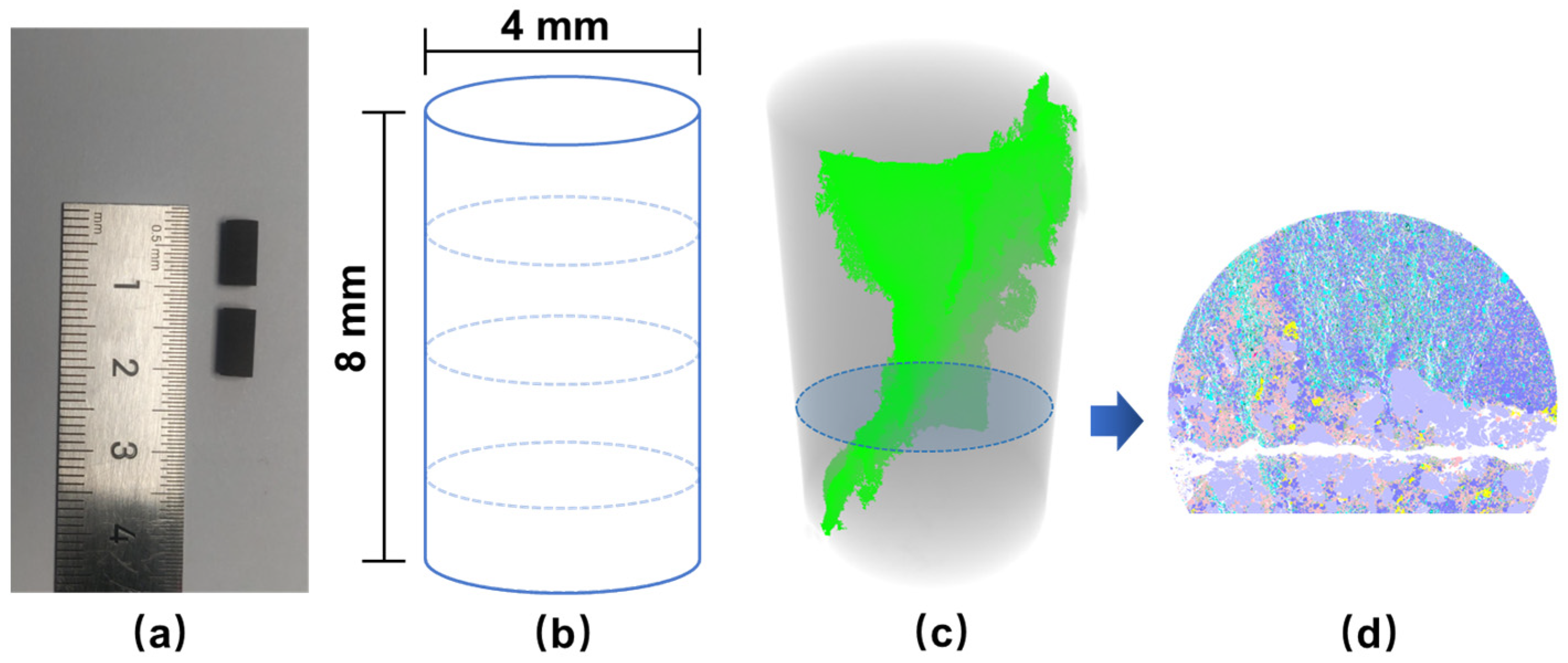

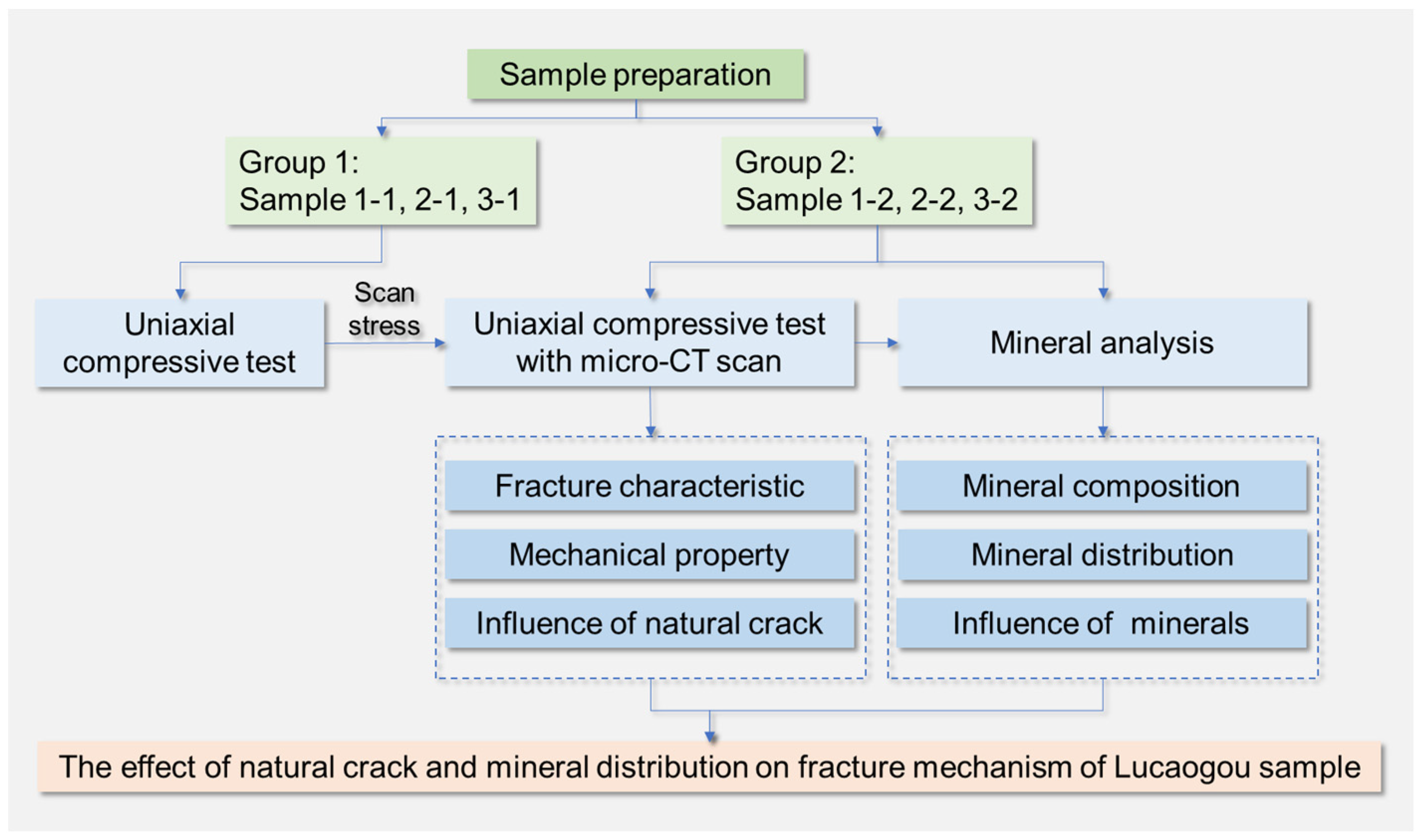
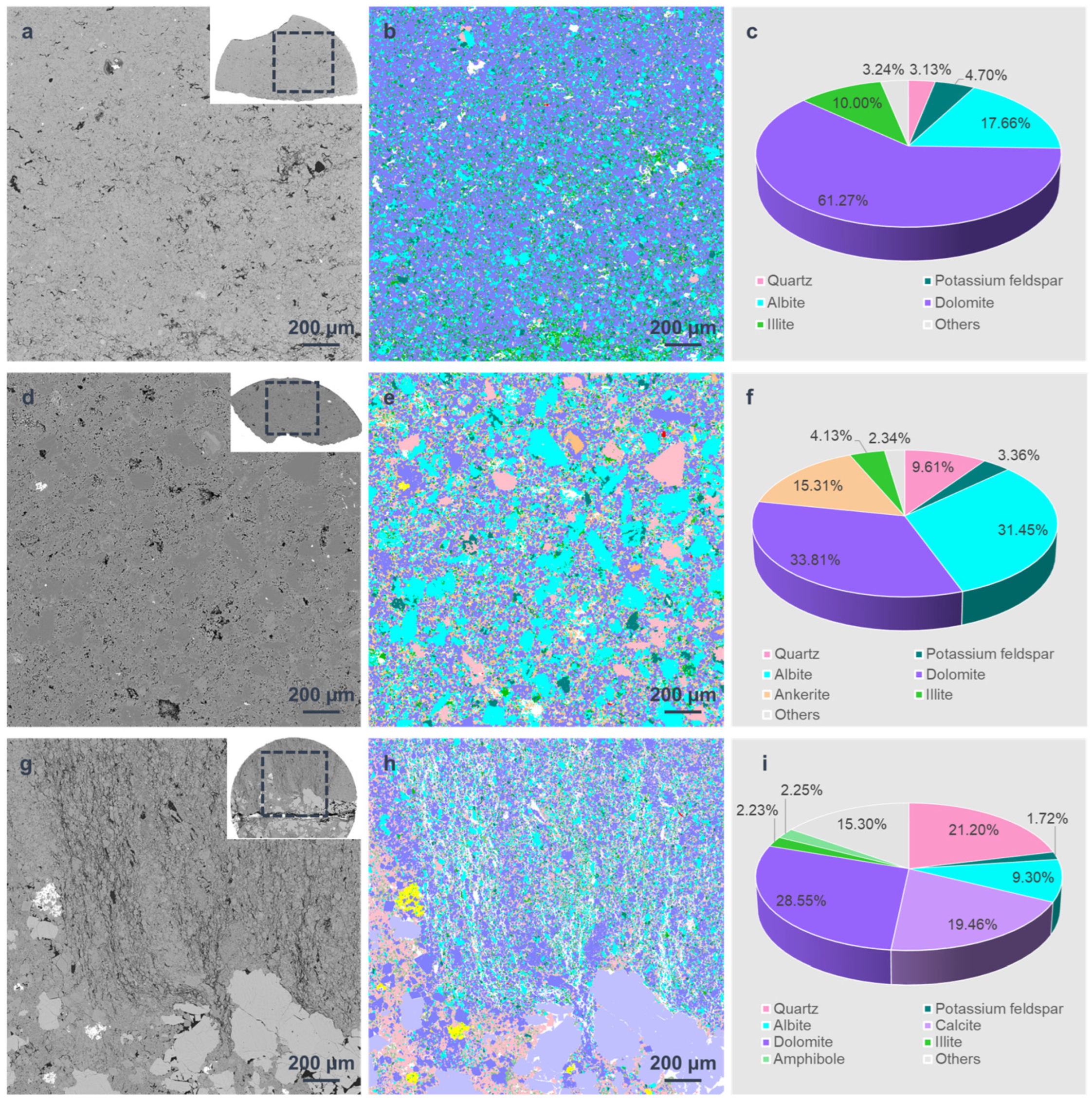
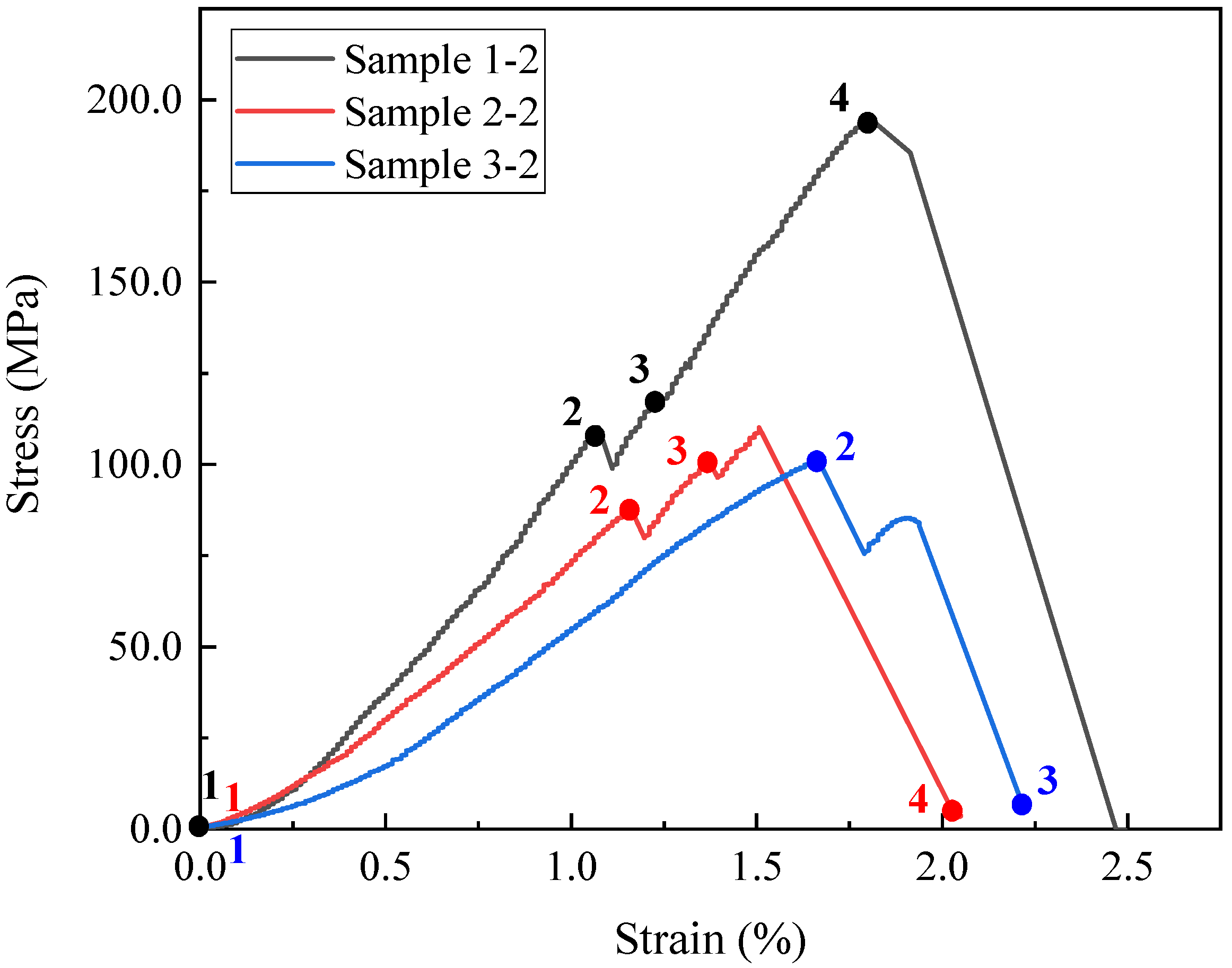
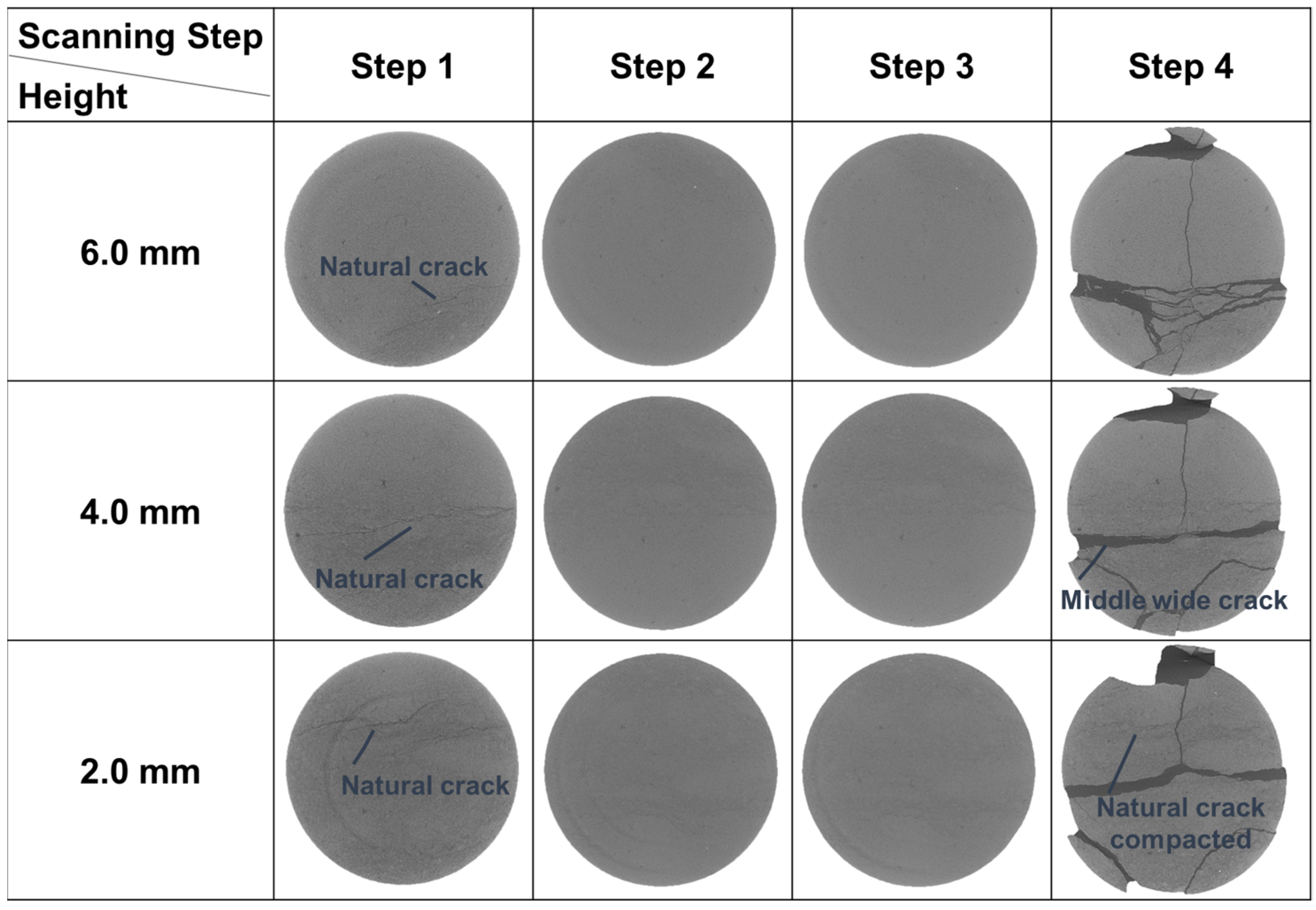
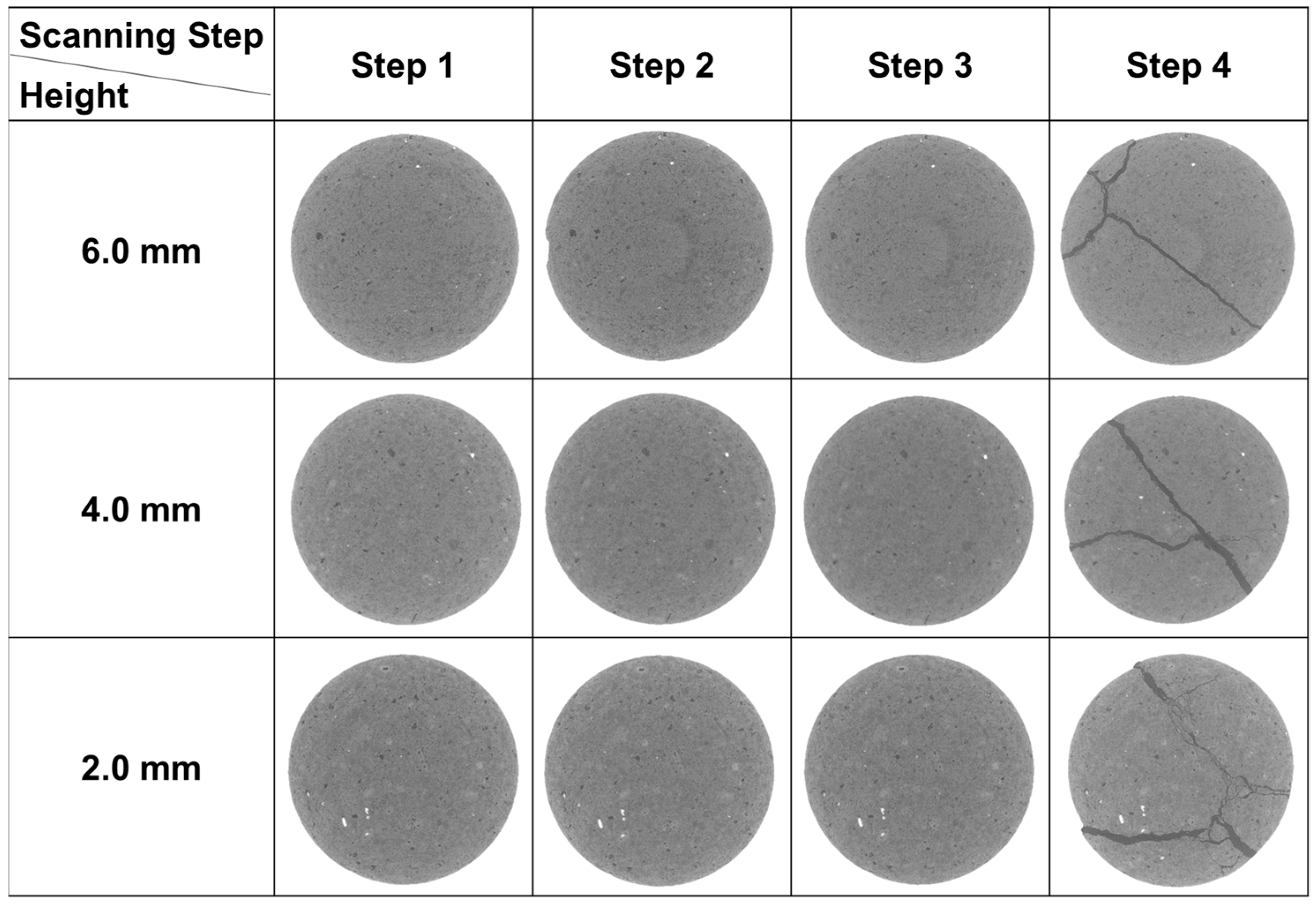
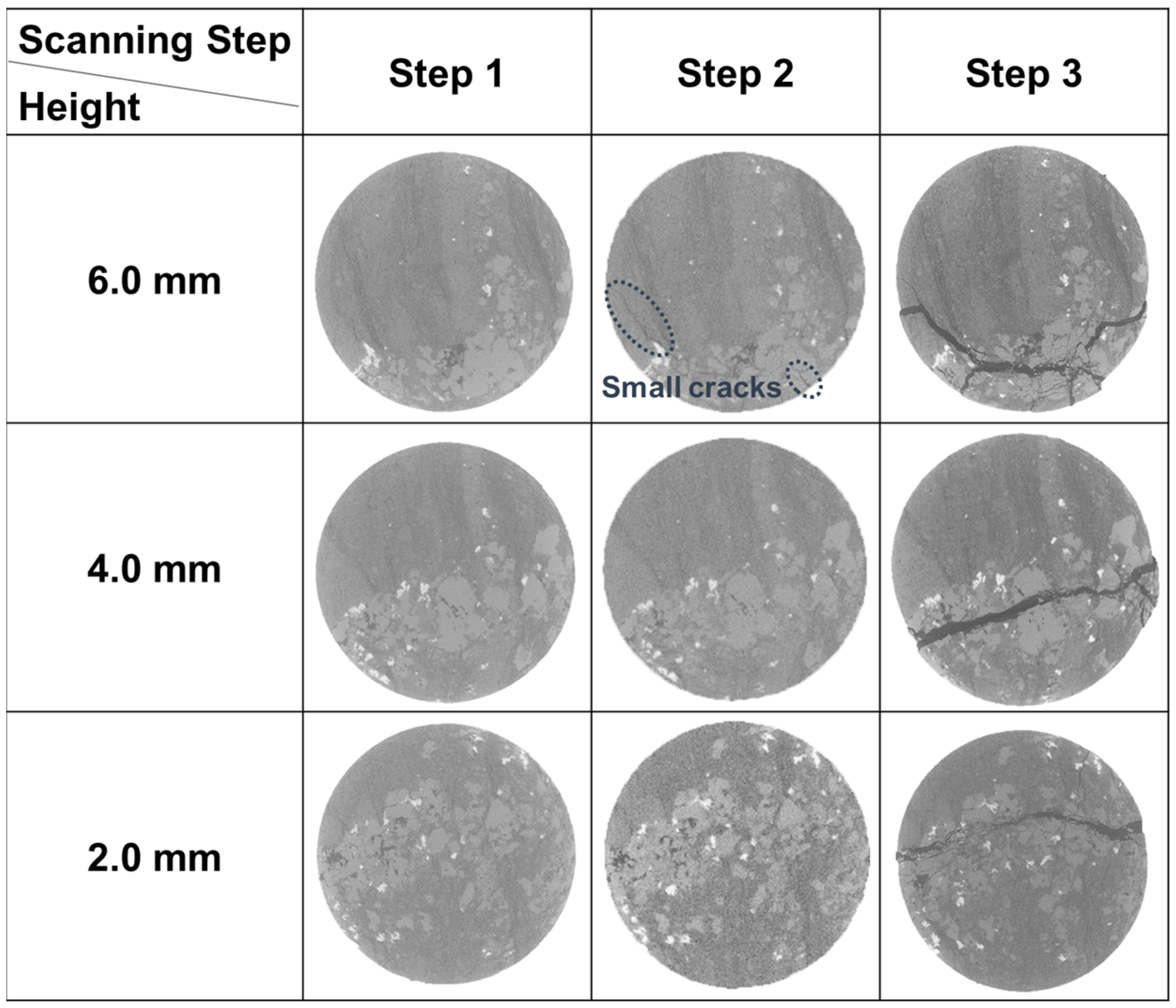



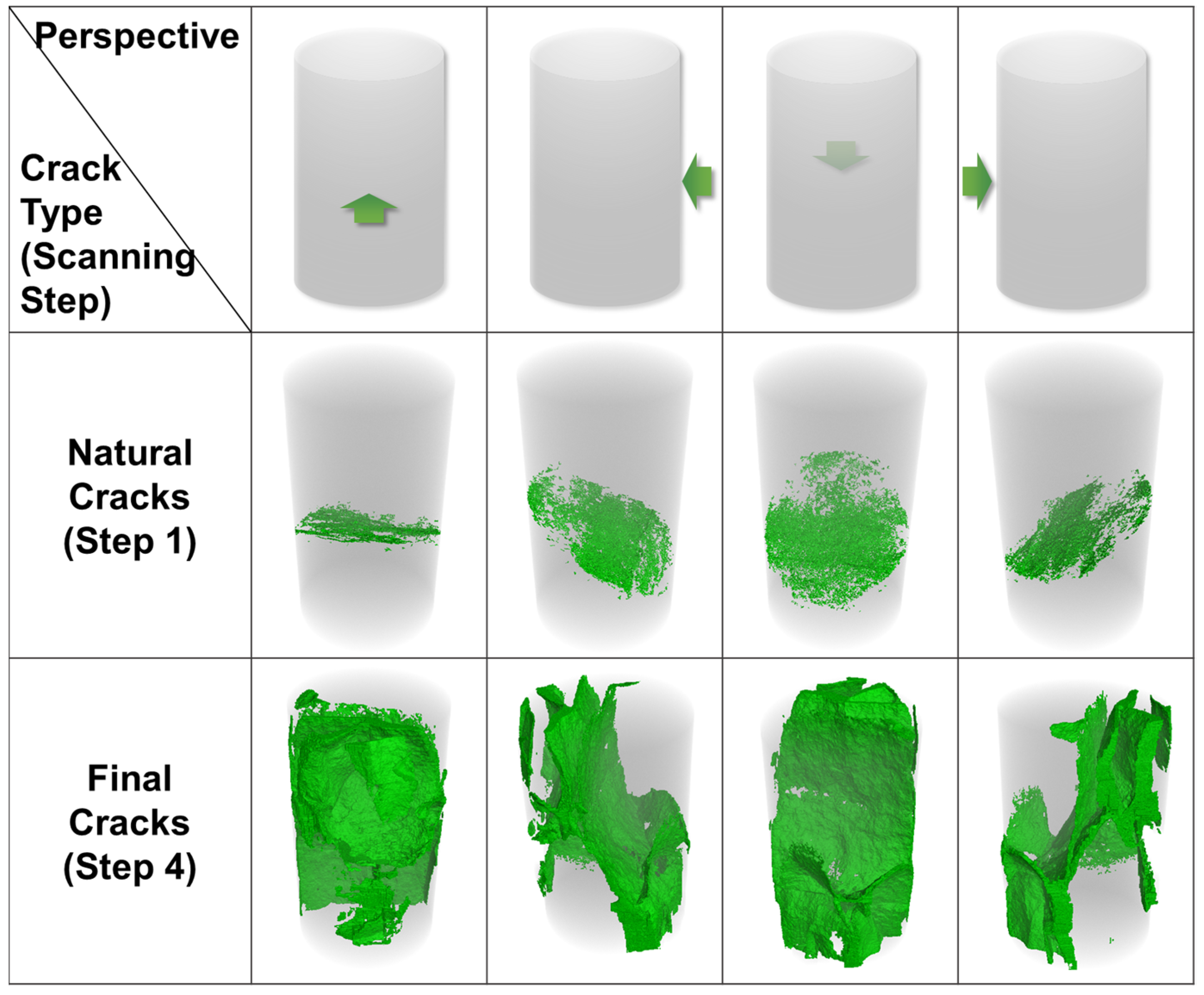
| Sample Number | Oil Layer/Interlayer | Surface Porosity (%) | UCS (MPa) | E (GPa) |
|---|---|---|---|---|
| 1-2 | Interlayer | 5.07 | 198.45 | 12.66 |
| 2-2 | Oil layer | 13.50 | 115.32 | 8.67 |
| 3-2 | Interlayer | 10.30 | 102.95 | 7.75 |
| Region Number | 1 | 2 | 3 | 4 | 5 | 6 |
|---|---|---|---|---|---|---|
| Quartz | 64.00 | 65.31 | 21.56 | 17.25 | 16.56 | 20.23 |
| Albite | 10.12 | 9.25 | 5.86 | 6.58 | 13.45 | 22.52 |
| Potassium feldspar | 0.77 | 1.48 | 1.28 | 1.00 | 4.04 | 4.80 |
| Dolomite | 12.21 | 10.14 | 63.32 | 69.17 | 29.21 | 22.54 |
| Amphibole | 7.76 | 8.02 | 0.51 | 0.69 | 1.28 | 0.79 |
| Clay | 0.71 | 0.96 | 1.08 | 1.61 | 5.06 | 7.33 |
| Crack and voids | 3.65 | 4.39 | 5.76 | 3.25 | 29.65 | 20.68 |
| Particle Size Range (μm) | Sample 2-2 (%) | Sample 3-2 (%) |
|---|---|---|
| 1–10 | 8.36 | 17.78 |
| 10–20 | 12.00 | 25.84 |
| 20–30 | 6.25 | 17.14 |
| 30–40 | 7.61 | 9.82 |
| 40–50 | 3.93 | 7.39 |
| 50–100 | 16.48 | 22.03 |
| >100 | 45.36 | 0.00 |
| All | 100 | 100 |
Disclaimer/Publisher’s Note: The statements, opinions and data contained in all publications are solely those of the individual author(s) and contributor(s) and not of MDPI and/or the editor(s). MDPI and/or the editor(s) disclaim responsibility for any injury to people or property resulting from any ideas, methods, instructions or products referred to in the content. |
© 2023 by the authors. Licensee MDPI, Basel, Switzerland. This article is an open access article distributed under the terms and conditions of the Creative Commons Attribution (CC BY) license (https://creativecommons.org/licenses/by/4.0/).
Share and Cite
Sun, X.; Li, S.; Li, X.; Li, G.; Zheng, B.; Mao, T. The Mechanical Properties and Fracture Characteristics of Shale Layered Samples from the Lucaogou Formation Considering Natural Crack and Mineral Distribution. Materials 2023, 16, 5881. https://doi.org/10.3390/ma16175881
Sun X, Li S, Li X, Li G, Zheng B, Mao T. The Mechanical Properties and Fracture Characteristics of Shale Layered Samples from the Lucaogou Formation Considering Natural Crack and Mineral Distribution. Materials. 2023; 16(17):5881. https://doi.org/10.3390/ma16175881
Chicago/Turabian StyleSun, Xiukuo, Shouding Li, Xiao Li, Guanfang Li, Bo Zheng, and Tianqiao Mao. 2023. "The Mechanical Properties and Fracture Characteristics of Shale Layered Samples from the Lucaogou Formation Considering Natural Crack and Mineral Distribution" Materials 16, no. 17: 5881. https://doi.org/10.3390/ma16175881






